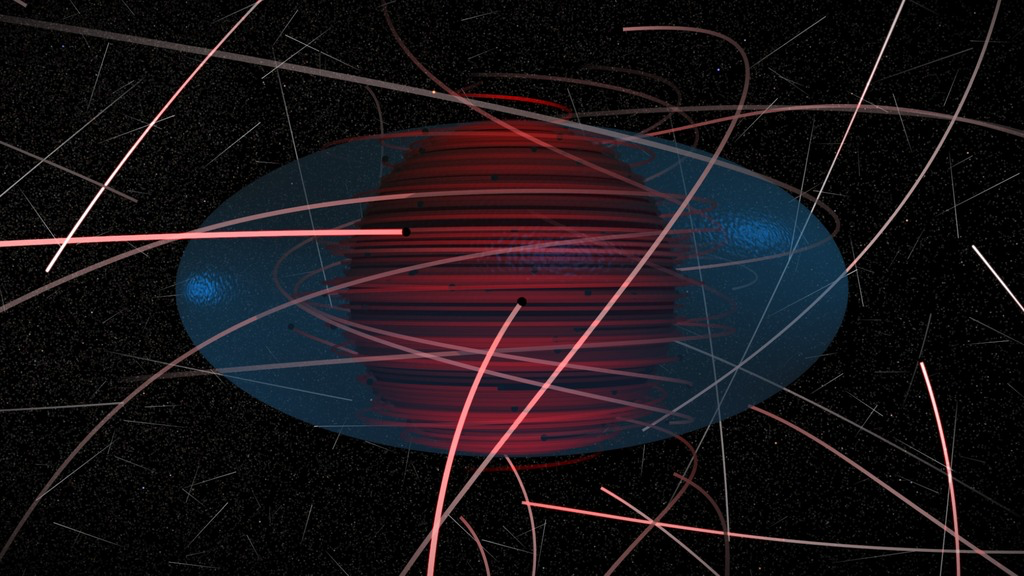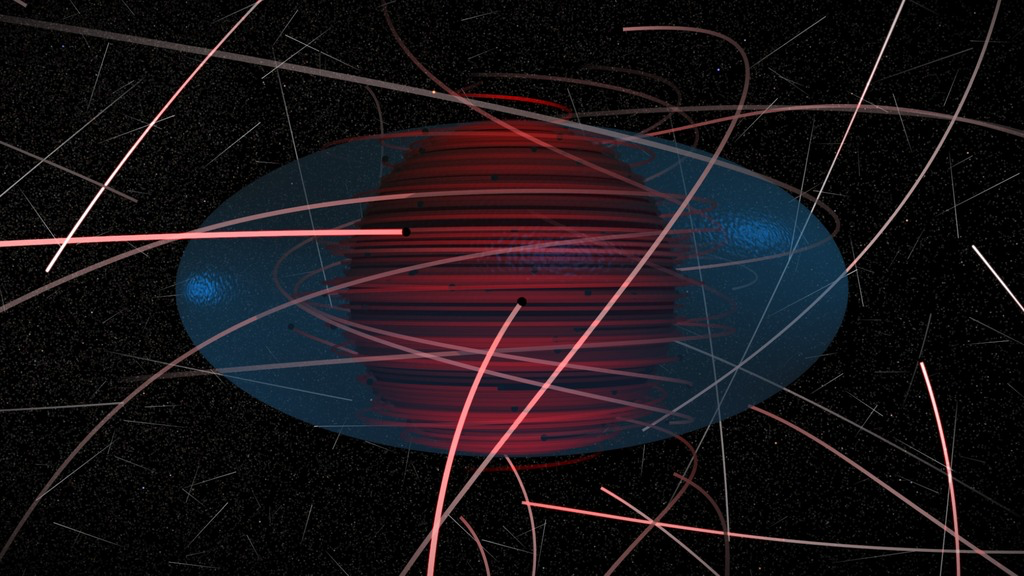Energy Boost from Black Holes
Black holes are mostly takers, not givers, but collisions among matter around a spinning black hole can result in high-energy particles that emerge with some of the black hole’s energy. Decades-old calculations showing only a modest energy gain for such particles are now contradicted by new results from two theoretical efforts showing that a particle can take away more than times the energy that was put in. There are still questions about the feasibility of such collisions, but they might help astrophysicists understand some unexplained observations, such as an excess of gamma rays from the galactic center or ultrahigh-energy cosmic rays.
Astrophysicists have often pondered the unusual phenomena that might occur in the strong gravity near a black hole. In 1969, Roger Penrose, then at Cambridge University in the UK, discovered a mechanism by which some particles orbiting around a spinning black hole could escape the strong gravitational field by stealing energy from the hole [1].
According to general relativity, the spinning black hole drags spacetime and everything in its immediate vicinity around with it. Penrose found that some material in this nearby region can have negative energy if it moves fast enough against this flow, like a swimmer fighting against a fast current. For the energy budget to remain balanced, some other material must gain energy. This situation can occur, for example, if two particles collide near a rotating black hole, launching one particle in the “upstream” direction, while the other particle escapes with energy greater than that of the two initial particles. Many researchers explored whether the Penrose process could lead to high-energy black hole emissions [2], but the maximum energy of the escaping particle was found to be only times the initial energy.
Despite this modest energy gain, researchers continued to study black holes as particle accelerators that could produce high-speed collisions not attainable anywhere else. “The idea has been to use black holes to study dark matter,” says Jeremy Schnittman of the NASA Goddard Space Flight Center in Greenbelt, Maryland. Dark matter has no charge, so it can’t be accelerated in the same way as protons and electrons. A few years ago, Schnittman designed a computer code in which he could “drop” dark matter particles into a black hole collider and see what came out. He assumed that the collisions produced gamma rays, but he was surprised to find some of the exiting gamma rays had much higher energy than the initial particles.
After some head-scratching, Schnittman realized that the extra energy was coming from the Penrose process, but in a way that hadn’t been considered before. Previous work had assumed the initial particles collide when they reach their maximum speed, which is right as they fall into the event horizon. But then the escaping particle expends nearly all of its energy moving against gravity on its outward trip. “The black hole giveth, and the black hole taketh away,” Schnittman says. He redid the calculations, but he assumed that one of the initial particles swings, or sling shots, around the black hole and is actually on an outbound trajectory when it collides with the other particle. Although the collision energy is slightly less than it could be, the outward momentum of the sling-shotted particle causes one particle to emerge with more energy, as much as times the initial combined energy, Schnittman found.
Emanuele Berti of the University of Mississippi and his colleagues explored what might happen if the outward-going initial particle originates—not from a sling-shot—but from a collision occurring very near the black hole horizon. This “pre-collision” opens up a wider range of outward momenta for the colliding particles, and the resulting energy gain has no theoretical limit. Berti and his colleagues found cases where an escaping particle could have over a million times the energy of the colliding particles. It’s worth noting, though, that if one works backwards and accounts for the energy that goes into the pre-collision, then the overall gains are in the same range as Schnittman found. But Berti and his colleagues think that just a few outward-going particles of the kind envisaged by Schnittman could produce cascades of efficient collisions that would ratchet up the outbound particle’s energy.
More elaborate black hole simulations [3] are needed to determine how often, if at all, these sorts of high-gain events occur, says Schnittman. If they are common enough, their signature may be seen in the gamma-ray emission from galactic centers, or perhaps in the highest energy cosmic rays.
Tomohiro Harada of Rikkyo University in Japan says the probability of these types of events may be very small, but they could potentially arise in astrophysical situations with complicated accretion disks and strong magnetic fields. The only way to be sure of their likelihood is to make observations, Harada says. Joseph Silk of the Paris Institute of Astrophysics and Johns Hopkins University in Baltimore says that these proposed events “can result in high energy phenomena that are detectable by future neutrino or gamma ray telescopes.”
This research is published in Physical Review Letters.
–Michael Schirber
Michael Schirber is a Corresponding Editor for Physics Magazine based in Lyon, France.
References
- R. Penrose, “Gravitational collapse: the role of general relativity,” Riv. Nuovo Cimento Ser. 1, 1, 252 (1969)
- M. Bañados, J. Silk, and S. M. West, “Kerr Black Holes as Particle Accelerators to Arbitrarily High Energy,” Phys. Rev. Lett. 103, 111102 (2009)
- J. D. Schnittman, “The Distribution and Annihilation of Dark Matter Around Black Holes,” Ap. J. 806 264 (2015)





